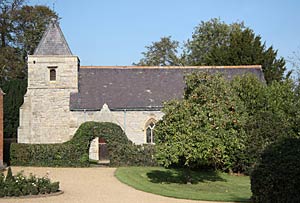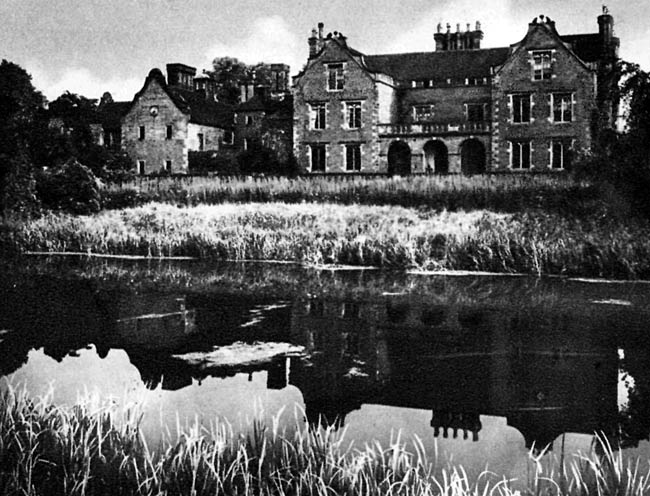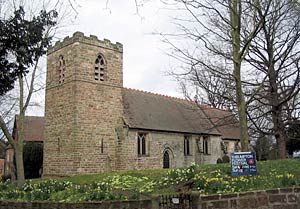< Previous | Contents | Next >
The Silver Cup

Thorpe church in 2011.
© Copyright Richard Croft and licensed for reuse under this Creative Commons Licence
THORPE. The sight of its small church from the Fosse Way calls us to this secluded village near Newark. Standing beyond the rectory lawn at a bend of the road, it was rebuilt in 1873 except for the low 13th century buttressed tower with a pyramid top. The font is a curious combination of an old step, a 14th century shaft, and a small bowl which may have been a Norman stoup; its domed cover is 17th century. Three other relics are a pillar piscina, a piscina niche, and a Jacobean coffin stool.
A window showing the Women at the Tomb is in memory of one of Kitchener's Fighting Scouts in South Africa. Nearly six centuries ago Sir William de Thorpe was fighting at Crecy, and was one of the company who saw Calais surrendered to their king; here in the church lies the battered stone figure of his widow, wearing a wimple, her feet resting on a dog, her arms broken.
One of the treasures of the altar is a silver cup given by Henry Druell as a thankoffering for his safe return from London in 1665, when the plague was raging.
Old-World by the River
THRUMPTON. Even the swift-flowing Trent lingers here, making a backwater where the ferryboat waits; and red houses and farms climb gently past the arched and turreted entrance of the gabled hall to the little church above the wayside. It is an old-world corner.

Thrumpton Hall in the 1930s.
The great house with mellowed brick walls stands by the river, sheltered by woods which clothe the hillside. It was refashioned in the 17th century by the Pigots, who gave it the carved oak staircase at the time of the Restoration. Before the Pigots, Thrumpton was for centuries the home of the Powtrells, who lost their estates through being concerned in the Gunpowder Plot; and Henry Garnett, one of the conspirators, is said to have known of the hidden stairway here, and of the secret room cut out in the cellars, even if he did not use them. Now the hall is the home of Lord Byron.
Among the magnificent trees in the grounds is a group of elms which were saplings when the Tudor dynasty was rising to its Golden Age. Two towering larches are perhaps unsurpassed in the county, and four cedars are living memorials of notable events, commemorating the Jubilee of George the Third, the crowning of George the Fourth, Queen Victoria's Jubilee, and the end of the Great War. There is a charming rose garden prettily laid out with tiny paths.
In the stillness of the lovely churchyard with its glorious elms and limes, a soldier in uniform lies in a recess of the church wall, a memorial to three men who did not come back, striking in its lifelike simplicity.

Thrumpton church in 2008.
© Copyright Tim Heaton and licensed for reuse under this Creative Commons Licence
Pleasing and cared-for (though dim with coloured glass) the church was much restored when the chancel was made new in 1872, but it has its 13th and 14th century low tower, and the massive old font stands in the churchyard. Memorials of the Pigots, Emmertons, and Westcombs are in the tower. It was through the Emmertons, who followed the Pigots, that Thrumpton came to the Byrons.
George Alvey, who was born in the village and worked for the Byrons all his life, had just ended his 82 years when we called. For 70 years he was a bellringer, and was never known to be absent. For 45 years he served as clerk and sexton.
